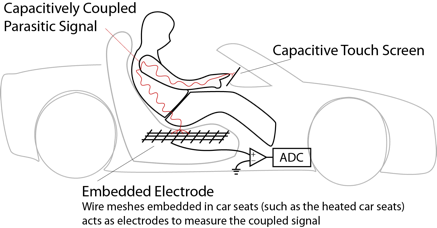@inproceedings{Wang:2017:CRC:3126594.3126623,
author = {Wang, Edward Jay and Garrison, Jake and Whitmire, Eric and Goel, Mayank and Patel, Shwetak},
title = {Carpacio: Repurposing Capacitive Sensors to Distinguish Driver and Passenger Touches on In-Vehicle Screens},
booktitle = {Proceedings of the 30th Annual ACM Symposium on User Interface Software and Technology},
series = {UIST '17},
year = {2017},
isbn = {978-1-4503-4981-9},
location = {Qu\&\#233;bec City, QC, Canada},
pages = {49--55},
numpages = {7},
url = {http://doi.acm.org/10.1145/3126594.3126623},
doi = {10.1145/3126594.3126623},
acmid = {3126623},
publisher = {ACM},
address = {New York, NY, USA},
keywords = {capacitive sensing, driver assistance, driver detection, touch, vehicle infotainment},
}

